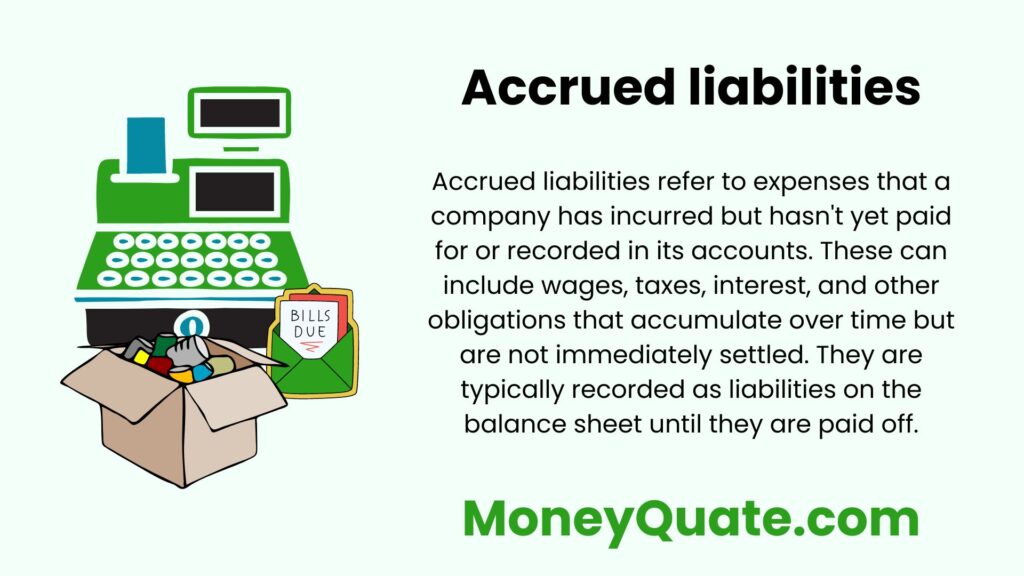Accrued liabilities refer to expenses that a company has incurred but has not yet paid as of the end of an accounting period. These liabilities represent obligations to make future payments for goods or services that have been received or utilized. Accrued liabilities are recorded on the balance sheet as part of the company’s current liabilities. Here’s a detailed breakdown:

Contents
Key Characteristics of Accrued Liabilities
Nature of Expenses:
Accrued liabilities typically arise from various operating expenses that have been incurred but not yet paid.
Example: Employee salaries, utility bills, or rent are common expenses that can lead to accrued liabilities.
Timing of Recognition:
Accrued liabilities are recognized at the end of an accounting period, even if the actual payment will occur in the subsequent period.
Example: If a company’s financial year ends on December 31, but it pays its employees on January 5, the accrued liability for December’s wages is recorded.
Obligation to Pay:
The company has a legal or contractual obligation to make payments related to accrued liabilities.
Example: An organization is obligated to pay its monthly rent, even if the actual payment is made after the end of the month.
Financial Statement Impact:
Accrued liabilities impact both the income statement and the balance sheet.
Example: Accrued salaries are recognized as an expense on the income statement, and the corresponding liability appears on the balance sheet.
Examples of Accrued Liabilities
Accrued Salaries:
Unpaid wages earned by employees, but not yet disbursed by the company.
Example: If the monthly payroll is on the 30th, and the financial period ends on the 15th, accrued salaries for the latter half of the month are recognized.
Accrued Utilities:
Unpaid utility expenses, such as electricity or water, that have been consumed but not yet billed.
Example: A manufacturing plant records accrued utility expenses for the electricity consumed during the last week of the month.
Accrued Rent:
Rental expenses that have been incurred but are not yet paid.
Example: If a business pays rent on a quarterly basis, but its financial period is monthly, accrued rent is recognized for the two months not covered by the current payment.
Accrued Interest:
Interest on loans or debt that has accrued but has not been paid.
Example: A company with a loan pays interest monthly but recognizes accrued interest for the days between the interest accrual date and the end of the financial period.
Importance of Accrued Liabilities
Accurate Financial Reporting:
Accrued liabilities ensure that financial statements accurately reflect the company’s financial position by recognizing expenses when incurred.
Example: Recognizing accrued salaries ensures that the income statement reflects the total cost of labor for the period.
Matching Principle:
Accrued liabilities align with the matching principle, matching expenses with the revenues they generate.
Example: Accrued utilities recognize the cost of electricity in the same period it contributes to production.
Cash Flow Management:
Monitoring accrued liabilities aid in managing cash flow by anticipating upcoming payment obligations.
Example: Being aware of accrued rent allows a business to plan for the upcoming rent payment.
Recording Accrued Liabilities
Adjusting Entries:
Companies make adjusting journal entries at the end of an accounting period to recognize accrued liabilities.
Example: An adjusting entry is made to recognize accrued salaries by debiting the salary expense account and crediting the accrued liabilities account.
Impact on Financial Statements:
Accrued liabilities impact the income statement by increasing expenses and the balance sheet by increasing current liabilities.
Example: The income statement reflects higher total expenses, and the balance sheet shows increased liabilities.
Conclusion
Accrued liabilities play a crucial role in ensuring that a company’s financial statements accurately portray its financial position and performance. By recognizing expenses when incurred, businesses adhere to accounting principles, make informed financial decisions, and maintain effective cash flow management.
1 thought on “The Hidden Ledger: Accrued Liabilities in Plain Language”